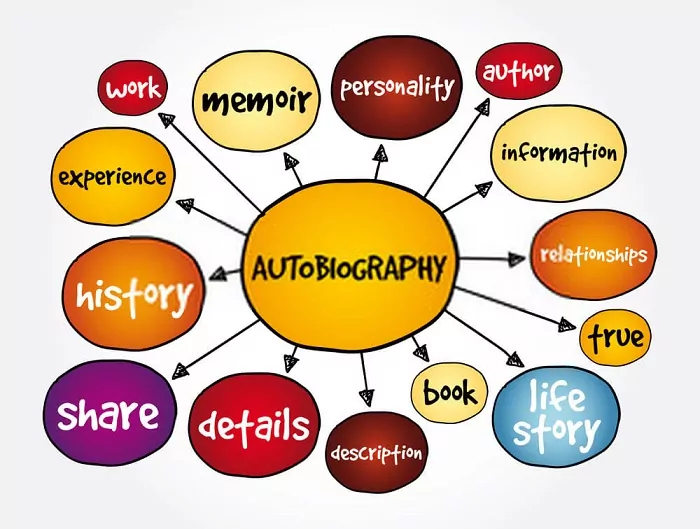What is an Autobiography?
To define it simply, an autobiography is a non-fictional narration written by a writer (subject) about their own life from their perspective. Because everyone has a story- it could be long or short- that is what makes an autobiography.
Autobiographies fall under the genre of biographies and are common among the general readings accessible to the public.
There is always something that fascinates you or that which your friends define you as. And when you share that something with the world, you will be writing an autobiography. Unlike a biography that is an account of someone written by someone else, an autobiography is written by a person : you write your own autobiography but someone writes your biography.

There are various types of autobiography formats you can choose to adopt.
Autobiographies need to flow in a particular format. There are many formats to follow when writing an autobiography. They include:
1. Traditional Autobiography Format
This is a format where the author begins recording events chronologically from birth to their current situation. Some of the notable traditional autobiography examples include: The autobiography by the late Nelson Mandela titles Long Walk to Freedom.
This type of autobiography is the fullest and longest story someone writes about themselves. In most cases, these are written for personal use, which helps store memories. In some circumstances, prominent people write their autobiographies for sale. We’ve seen autobiographies of prominent people like Obama, Nelson Mandela, Trevor Noah, and Paramahansa Yogananda.

2. Vignettes
In this autobiography format, the author presents their story in the form of short chapters that describe and focus on particular events in the life of the author. Therefore, to complete a full autobiography, the author combines a collection of Vignettes. A sound autobiography example following the format is the
“A Well-Lighted Café section written by Ernest Hemingway’ It was very late, and everyone had left the café except an old man who sat in the shadow the leaves of the tree made against the electric light. In the daytime, the street was dusty, but at night the dew settled the dust, and the old man liked to sit late because he was deaf and now at night it was quiet, and he felt the difference. The two waiters inside the café knew that the old man was a little drunk, and while he was a good client, they knew that if he became too drunk, he would leave without paying, so they kept watching on him.”
3. Personal Narrative Autobiographies
Unlike the vignettes which focus on the events, the personal narratives or personal essays focus on a single moment. In this autobiography example, the events are described through dialogue or imagery. Essentially, students are usually assigned autobiography essays where they detail their experiences at one moment. It is also a common feature on the part of personal essays and admission essays.
Proven Tips to Make Your Autobiography Interesting
- Grab the attention of your audience from the onset
- Keep it logical
- Make it interesting and brief
- Write from the first-person perspective
- Have a central theme
- Understand the audience
- Mind your tenses and tone
- Avoid triviality
How to Write an Autobiography Outline/Structure
An outline for your autobiography helps you understand what falls where and organize its flow. Remember, an autobiography has to have an introduction, body, and conclusion.
The structure depends on the type of autobiographical writing you are doing. However, since this guide depends on the basic autobiography structure, here are the basic autobiographical structuring principles you should adhere to when writing your essay.
-
The Introduction
The introduction should be clear and concise about who you are. Fundamentally, this means a brief and succinct description of yourself, your early life, challenges, and how you got to where you are. Ultimately, you can also define the theme (s) at this level.
We have written an entire section on how to start an autobiography (in the later sections of this guide). It is no different from an introductory paragraph of an essay. It serves as an entry point that grabs the attention of the readers and presents them with the gist of your writing.
It should not be very long but clear, concise, and coherent. Besides, it has to provide your portrait to the readers so that they understand your story from your perspective.
-
The Main Body
The body should have segments of your life in paragraphs to give an understanding of every event and occurrence. You should highlight the childhood phase, adolescent phase, early adulthood phase, and more in that order. Vividly, it is also in this segment that you highlight your hobbies, academic achievements, and experiences including jovial and sad moments.
In short college autobiographical essays, the body can be a paragraph or two. However, in longer autobiography writings, the paragraphs can be more, each with its idea.
As a rule of the thumb, the main body forms 80% of the total word count. The remaining 10% goes to the intro and the 10% to the conclusion.
-
The conclusion
In the closing paragraph of your autobiography ensure that you exercise brevity. You would want to present the theme, and the lesson of your life, your quotes, or your personal philosophy-just make it different and unique. It is also here that you highlight the intention of writing the autobiography.
Make it impressive, strong, and engaging enough to create some link and make your readers yearn to read more. Mention the lessons, changes you’ve made to life, and the new world views that have emerged. If there are negative encounters, talk about how your values and resilience enabled you to overcome them.